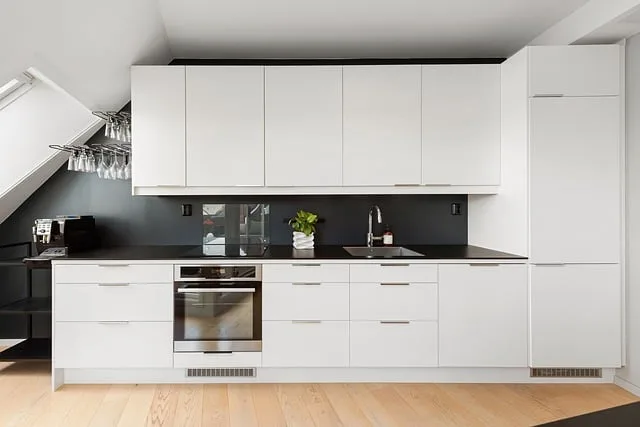Start by emptying your cabinets. It’s a bit like decluttering your mind—once you clear out the mess, you can see what you’re working with. Next, mix equal parts of water and white vinegar in your spray bottle. Vinegar is a natural mold killer, and it’s safe to use around food. Spray the affected areas generously and let it sit for about 10-15 minutes. This is the part where you can sip your coffee and let the vinegar do its magic.
After the wait, take your soft cloth and wipe down the cabinets. You might need to put a little elbow grease into it, especially if the mold is stubborn. If you encounter a particularly tough spot, sprinkle some baking soda on it. It’s like giving the mold a one-two punch! The baking soda will help lift the mold while also deodorizing the area.
Once you’ve scrubbed away the mold, rinse the cloth and wipe down the cabinets again with plain water to remove any residue. Don’t forget to dry everything thoroughly—mold loves moisture, so keep it at bay!
Banish the Black: Effective Strategies to Remove Mold from Your Kitchen Cabinets
First off, prevention is key. Keep your kitchen well-ventilated. Open windows or turn on that exhaust fan while cooking. Think of it as giving your cabinets a breath of fresh air. If moisture is a frequent visitor, consider using a dehumidifier. It’s like a bouncer for your kitchen, keeping unwanted humidity at bay.
Now, if you’ve already spotted that pesky mold, don’t panic! Grab some white vinegar—nature’s own cleaning superhero. Spray it directly on the moldy areas and let it sit for about an hour. The acidity in vinegar works wonders, breaking down the mold without harsh chemicals. Afterward, wipe it away with a damp cloth. It’s like giving your cabinets a spa day!
For tougher spots, a mixture of baking soda and water can be your best friend. This combo not only tackles mold but also leaves a fresh scent behind. Just make a paste, apply it to the affected areas, and scrub gently. It’s like a mini workout for your cabinets!
Mold No More: A Step-by-Step Guide to Reviving Your Kitchen Cabinets
First things first, gather your supplies. You’ll need a good mold cleaner—something like vinegar or a store-bought solution works wonders. Grab some soft cloths, a scrub brush, and a pair of rubber gloves to protect your hands. Trust me, you don’t want to be shaking hands with mold!
Now, let’s get to work. Start by removing everything from your cabinets. It’s like a mini spring cleaning! Once they’re empty, spray your chosen cleaner generously on the affected areas. Let it sit for a few minutes—this is the magic moment when the cleaner starts breaking down that pesky mold.
Next, take your scrub brush and gently scrub the moldy spots. Think of it as giving your cabinets a spa day. Rinse the brush frequently to avoid spreading the mold around. After scrubbing, wipe down the surfaces with a damp cloth to remove any residue.
But wait, we’re not done yet! To prevent mold from making a comeback, ensure your kitchen is well-ventilated. Open windows, use exhaust fans, and keep humidity levels in check. It’s like giving your cabinets a breath of fresh air!
From Grimy to Gleaming: Top Tips for Mold Removal in Kitchen Spaces
First off, you need to identify the mold’s favorite hangouts. Kitchens are often humid, making them a prime spot for mold to thrive. Check under the sink, around the fridge, and behind appliances. It’s like a game of hide-and-seek, but you’re the one seeking a clean kitchen!
Once you’ve found the mold, it’s time to gear up. Grab some gloves, a mask, and a scrub brush. You wouldn’t go into battle without armor, right? For a natural cleaning solution, mix equal parts vinegar and water in a spray bottle. Vinegar is like the superhero of mold removal—tough on mold but gentle on your surfaces.
Spray the affected areas and let it sit for about an hour. This is your chance to kick back and relax while the vinegar does its magic. After an hour, scrub away! It’s like giving your kitchen a mini spa day. Rinse the area with water and dry it thoroughly. Mold loves moisture, so keep things dry to prevent it from coming back.
Now, let’s talk prevention. Keep your kitchen well-ventilated. Open windows, use exhaust fans, and consider a dehumidifier if your kitchen tends to feel like a sauna. Think of it as giving your kitchen a breath of fresh air—literally! Regularly check for leaks and fix them promptly. A small drip can lead to a big mold problem, and nobody wants that.
The Hidden Dangers of Mold: Why Your Kitchen Cabinets Need Immediate Attention
Mold thrives in damp, dark places, and your kitchen cabinets can be the perfect breeding ground. If you’ve ever spilled water or had a leaky pipe, you might unknowingly be providing a cozy home for mold spores. These tiny invaders can trigger allergies, respiratory issues, and even more severe health problems. It’s like inviting a party crasher who brings nothing but chaos and discomfort.

But wait, it gets worse! Mold doesn’t just affect your health; it can wreak havoc on your cabinets too. Over time, it can weaken the structure, leading to costly repairs or replacements. Think of it as a silent thief, slowly stealing the integrity of your kitchen. You wouldn’t let a thief roam free in your home, so why let mold take over your cabinets?

Now, you might be wondering how to spot this sneaky intruder. Look for discoloration, a musty smell, or even peeling paint. If you notice any of these signs, it’s time to take action. Don’t just wipe it away; you need to address the root cause. Is there a leak? Is the humidity too high? Tackling these issues head-on is crucial to keeping your kitchen safe and mold-free.
So, the next time you reach for that favorite frying pan, take a moment to check your cabinets. Your health and your kitchen deserve better than to be overshadowed by the hidden dangers of mold.
Frequently Asked Questions
When should I consider replacing my kitchen cabinets due to mold?
Consider replacing your kitchen cabinets if you notice persistent mold growth, a musty odor, or visible water damage. If cleaning does not resolve the issue or if the mold returns, it may indicate deeper moisture problems that require cabinet replacement to ensure a healthy environment.
What are the best methods to remove mold from kitchen cabinets?
To effectively remove mold from kitchen cabinets, start by emptying the cabinets and ensuring proper ventilation. Use a mixture of water and mild detergent or a solution of vinegar and water to scrub the affected areas. For tougher mold, a diluted bleach solution can be applied, but ensure to wear gloves and a mask. After cleaning, dry the surfaces thoroughly to prevent future growth. Regularly check for moisture and consider using a dehumidifier to maintain a dry environment.
What cleaning solutions are safe for kitchen cabinets?
For cleaning kitchen cabinets, use mild solutions such as a mixture of warm water and dish soap, vinegar diluted with water, or a gentle all-purpose cleaner. Avoid harsh chemicals and abrasive materials that can damage the finish. Always test a small, inconspicuous area first.
How can I prevent mold from returning after cleaning?
To prevent mold from returning after cleaning, ensure that the area is thoroughly dried and ventilated. Use dehumidifiers to maintain low humidity levels, fix any leaks, and regularly clean surfaces with mold-inhibiting solutions. Additionally, consider applying a mold-resistant sealant to vulnerable areas.
Are there any natural remedies for mold removal?
Natural remedies for mold removal include using vinegar, baking soda, and tea tree oil. Vinegar can kill most types of mold, while baking soda helps to absorb moisture and prevent mold growth. Tea tree oil is a potent antifungal that can effectively eliminate mold spores. These remedies are eco-friendly and can be applied directly to affected areas for effective results.